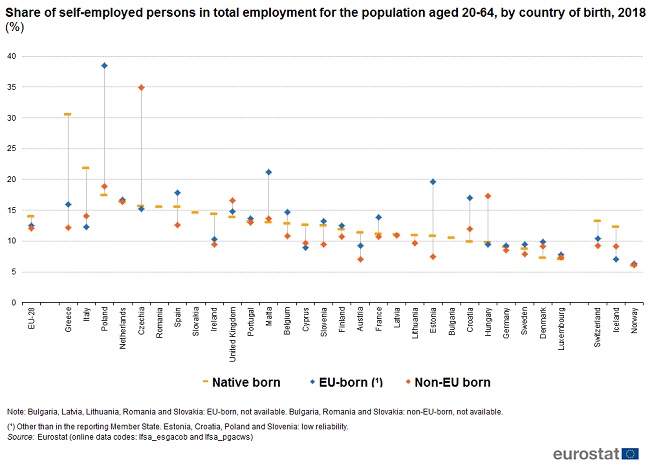Analytics, Demography, EU – Baltic States, Labour-market, Statistics
International Internet Magazine. Baltic States news & analytics
Friday, 19.04.2024, 09:00
Eurostat: Migrant integration – self-employed persons
 Print version
Print versionIn relative terms, the share of self-employed persons among
the native-born population in 2018 (14%) was higher than the share recorded for
foreign-born persons (13% for persons born in a different EU Member State and 12%
for persons born outside the EU).

The source datasets are accessible here and here.
Across the EU Member States and for persons in employment,
three out of ten native-born people in Greece were self-employed in 2018 (31%)
and around one in five in Italy (22%) and Poland (18%). In contrast, the
self-employed persons among the native-born population accounted for less than
10% of total employment in Denmark and Luxembourg (both 7%) as well as in
Germany and Sweden (both 9%).
For persons born in a different EU Member State (than the
Member State of residence), the highest self-employment rate was recorded in
Poland (38%), followed - at some distance - by Malta (21%) and Estonia (20%).
At the opposite end of the scale, the lowest self-employment rates for persons
born in a different EU Member State were observed in Luxembourg (8%), followed
by Hungary, Sweden, Austria, Germany and Cyprus (each 9%).
The highest self-employment rate for persons born outside
the EU in 2018 was recorded in Czechia (35%), followed by Poland (19%),
Hungary, the United Kingdom (both 17%) and the Netherlands (16%). By
contrast, the lowest rates were recorded in Estonia, Luxembourg and Austria
(each 7%), followed by Sweden (8%), Slovenia, Ireland, Denmark and Germany
(each 9%).
Further information on migrant integration statistics
dedicated to employment conditions can be found in this Statistics Explained article.








 «The Baltic Course» Is Sold and Stays in Business!
«The Baltic Course» Is Sold and Stays in Business!

